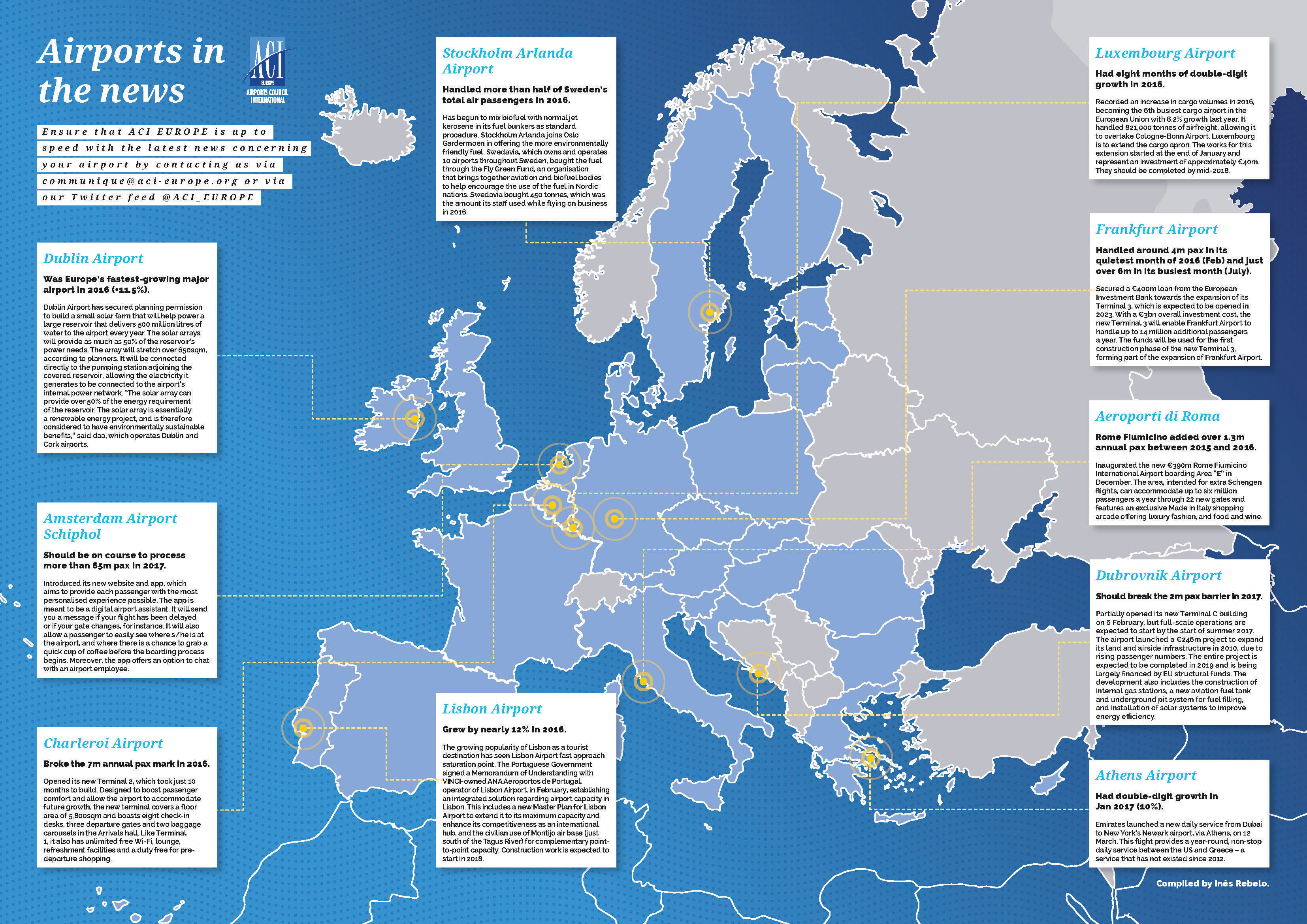
Dublin Airport
Was Europe’s fastest-growing major airport in 2016 (+11.5%).
Dublin Airport has secured planning permission to build a small solar farm that will help power a large reservoir that delivers 500 million litres of water to the airport every year. The solar arrays will provide as much as 50% of the reservoir’s power needs. The array will stretch over 650sqm, according to planners. It will be connected directly to the pumping station adjoining the covered reservoir, allowing the electricity it generates to be connected to the airport’s internal power network. “The solar array can provide over 50% of the energy requirement of the reservoir. The solar array is essentially a renewable energy project, and is therefore considered to have environmentally sustainable benefits,” said daa, which operates Dublin and Cork airports.
Amsterdam Airport Schiphol
Should be on course to process more than 65m pax in 2017.
Introduced its new website and app, which aims to provide each passenger with the most personalised experience possible. The app is meant to be a digital airport assistant. It will send you a message if your flight has been delayed or if your gate changes, for instance. It will also allow a passenger to easily see where s/he is at the airport, and where there is a chance to grab a quick cup of coffee before the boarding process begins. Moreover, the app offers an option to chat with an airport employee.
Charleroi Airport
Broke the 7m annual pax mark in 2016.
Opened its new Terminal 2, which took just 10 months to build. Designed to boost passenger comfort and allow the airport to accommodate future growth, the new terminal covers a floor area of 5,800sqm and boasts eight check-in desks, three departure gates and two baggage carousels in the Arrivals hall. Like Terminal 1, it also has unlimited free Wi-Fi, lounge, refreshment facilities and a duty free for pre-departure shopping.
Stockholm Arlanda Airport
Handled more than half of Sweden’s total air passengers in 2016.
Has begun to mix biofuel with normal jet kerosene in its fuel bunkers as standard procedure. Stockholm Arlanda joins Oslo Gardermoen in offering the more environmentally friendly fuel. Swedavia, which owns and operates 10 airports throughout Sweden, bought the fuel through the Fly Green Fund, an organisation that brings together aviation and biofuel bodies to help encourage the use of the fuel in Nordic nations. Swedavia bought 450 tonnes, which was the amount its staff used while flying on business in 2016.
Lisbon Airport
Grew by nearly 12% in 2016.
The growing popularity of Lisbon as a tourist destination has seen Lisbon Airport fast approach saturation point. The Portuguese Government signed a Memorandum of Understanding with VINCI-owned ANA Aeroportos de Portugal, operator of Lisbon Airport, in February, establishing an integrated solution regarding airport capacity in Lisbon. This includes a new Master Plan for Lisbon Airport to extend it to its maximum capacity and enhance its competitiveness as an international hub, and the civilian use of Montijo air base (just south of the Tagus River) for complementary point-to-point capacity. Construction work is expected to start in 2018.
Luxembourg Airport
Had eight months of double-digit growth in 2016.
Recorded an increase in cargo volumes in 2016, becoming the 6th busiest cargo airport in the European Union with 8.2% growth last year. It handled 821,000 tonnes of airfreight, allowing it to overtake Cologne-Bonn Airport. Luxembourg is to extend the cargo apron. The works for this extension started at the end of January and represent an investment of approximately €40m. They should be completed by mid-2018.
Frankfurt Airport
Handled around 4m pax in its quietest month of 2016 (Feb) and just over 6m in its busiest month (July).
Secured a €400m loan from the European Investment Bank towards the expansion of its Terminal 3, which is expected to be opened in 2023. With a €3bn overall investment cost, the new Terminal 3 will enable Frankfurt Airport to handle up to 14 million additional passengers a year. The funds will be used for the first construction phase of the new Terminal 3, forming part of the expansion of Frankfurt Airport.
Aeroporti di Roma
Rome Fiumicino added over 1.3m annual pax between 2015 and 2016.
Inaugurated the new €390m Rome Fiumicino International Airport boarding Area “E” in December. The area, intended for extra Schengen flights, can accommodate up to six million passengers a year through 22 new gates and features an exclusive Made in Italy shopping arcade offering luxury fashion, and food and wine.
Dubrovnik Airport
Should break the 2m pax barrier in 2017.
Partially opened its new Terminal C building on 6 February, but full-scale operations are expected to start by the start of summer 2017. The airport launched a €246m project to expand its land and airside infrastructure in 2010, due to rising passenger numbers. The entire project is expected to be completed in 2019 and is being largely financed by EU structural funds. The development also includes the construction of internal gas stations, a new aviation fuel tank and underground pit system for fuel filling, and installation of solar systems to improve energy efficiency.
Athens Airport
Had double-digit growth in Jan 2017 (10%).
Emirates launched a new daily service from Dubai to New York’s Newark airport, via Athens, on 12 March. This flight provides a year-round, non-stop daily service between the US and Greece – a service that has not existed since 2012.







